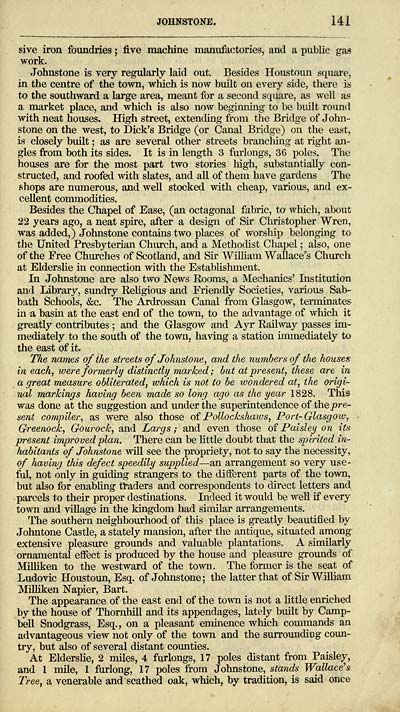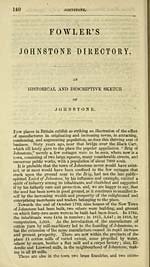Download files
Complete book:
Individual page:
Thumbnail gallery: Grid view | List view

JOHNSTONE. 141
sive iron foundries ; five machine manufactories, and a public gas
work.
Johnstone is very regularly laid out. Besides Houstoun square,
in the centre of the town, which is now built on every side, there is
to the southward a large area, meant for a second square, as well as
a market place, and which is also now beginning to be built round
with neat houses. High street, extending from the Bridge of John-
stone on the west, to Dick's Bridge (or Canal Bridge) on the east,
is closely built ; as are several other streets branching at right an-
gles from both its sides. It is in length 3 furlongs, 36 poles. The
houses are for the most part two stories high, substantially con-
structed, and roofed with slates, and all of them have gardens The
shops are numerous, and well stocked with cheap, various, and ex-
cellent commodities.
Besides the Chapel of Ease, (an octagonal fabric, to which, about
22 years ago, a neat spire, after a design of Sir Christopher Wren,
was added,) Johnstone contains two places of worship belonging to
the United Presbyterian Church, and a Methodist Chapel ; also, one
of the Free Churches of Scotland, and Sir William Wallace's Church
at Elderslie in connection with the Establishment.
In Johnstone are also two News Booms, a Mechanics' Institution
an<l Library, sundry Beligious and Friendly Societies, various Sab-
bath Schools, &c. The Ardrossan Canal from Glasgow, terminates
in a basin at the east end of the town, to the advantage of which it
greatly contributes ; and the Glasgow and Ayr Railway passes im-
mediately to the south of the town, having a station immediately to
the east of it.
The names of the streets of Johnstone, and the numbers of the houses
in each, were formerly distinctly marked; but at present, these are in
a great measure obliterated, which is not to be wondered at, the origi-
nal markings having been made so long ago as the year 1828. This
was done at the suggestion and under the superintendence of the pre-
sent compile?', as were also those of Pollockshaws, Port-Glasgow,
Greenock, Gourock, and Largs ; and even those of Paisley on its
present improved plan. There can be little doubt that the spirited in-
habitants of Johnstone will see the propriety, not to say the necessity,
of having this defect speedily supplied — an arrangement so very use-
ful, not only in guiding strangers to the different parts of the town,
but also for enabling traders and correspondents to direct letters and
parcels to their proper destinations. Indeed it would be well if every
town and village in the kingdom had similar arrangements.
The southern neighbourhood of this place is greatly beautified by
Johntone Castle, a stately mansion, after the antique, situated among
extensive pleasure grounds and valuable plantations. A similarly
ornamental effect is produced by the house and pleasure grounds of
Milliken to the westward of the town. The former is the seat of
Ludovic Houstoun, Esq. of Johnstone; the latter that of Sir William
Milliken Napier, Bart.
The appearance of the east end of the town is not a little enriched
by the house of Thornhill and its appendages, lately built by Camp-
bell Snodgrass, Esq., on a pleasant eminence which commands an
advantageous view not only of the town and the surrounding coun-
try, but also of several distant counties.
At Elderslie, 2 miles, 4 furlongs, 17 poles distant from Paisley,
and 1 mile, 1 furlong, 17 poles from Johnstone, stands Wallace's
Tree, a venerable and scathed oak, which, by tradition, is said once
sive iron foundries ; five machine manufactories, and a public gas
work.
Johnstone is very regularly laid out. Besides Houstoun square,
in the centre of the town, which is now built on every side, there is
to the southward a large area, meant for a second square, as well as
a market place, and which is also now beginning to be built round
with neat houses. High street, extending from the Bridge of John-
stone on the west, to Dick's Bridge (or Canal Bridge) on the east,
is closely built ; as are several other streets branching at right an-
gles from both its sides. It is in length 3 furlongs, 36 poles. The
houses are for the most part two stories high, substantially con-
structed, and roofed with slates, and all of them have gardens The
shops are numerous, and well stocked with cheap, various, and ex-
cellent commodities.
Besides the Chapel of Ease, (an octagonal fabric, to which, about
22 years ago, a neat spire, after a design of Sir Christopher Wren,
was added,) Johnstone contains two places of worship belonging to
the United Presbyterian Church, and a Methodist Chapel ; also, one
of the Free Churches of Scotland, and Sir William Wallace's Church
at Elderslie in connection with the Establishment.
In Johnstone are also two News Booms, a Mechanics' Institution
an<l Library, sundry Beligious and Friendly Societies, various Sab-
bath Schools, &c. The Ardrossan Canal from Glasgow, terminates
in a basin at the east end of the town, to the advantage of which it
greatly contributes ; and the Glasgow and Ayr Railway passes im-
mediately to the south of the town, having a station immediately to
the east of it.
The names of the streets of Johnstone, and the numbers of the houses
in each, were formerly distinctly marked; but at present, these are in
a great measure obliterated, which is not to be wondered at, the origi-
nal markings having been made so long ago as the year 1828. This
was done at the suggestion and under the superintendence of the pre-
sent compile?', as were also those of Pollockshaws, Port-Glasgow,
Greenock, Gourock, and Largs ; and even those of Paisley on its
present improved plan. There can be little doubt that the spirited in-
habitants of Johnstone will see the propriety, not to say the necessity,
of having this defect speedily supplied — an arrangement so very use-
ful, not only in guiding strangers to the different parts of the town,
but also for enabling traders and correspondents to direct letters and
parcels to their proper destinations. Indeed it would be well if every
town and village in the kingdom had similar arrangements.
The southern neighbourhood of this place is greatly beautified by
Johntone Castle, a stately mansion, after the antique, situated among
extensive pleasure grounds and valuable plantations. A similarly
ornamental effect is produced by the house and pleasure grounds of
Milliken to the westward of the town. The former is the seat of
Ludovic Houstoun, Esq. of Johnstone; the latter that of Sir William
Milliken Napier, Bart.
The appearance of the east end of the town is not a little enriched
by the house of Thornhill and its appendages, lately built by Camp-
bell Snodgrass, Esq., on a pleasant eminence which commands an
advantageous view not only of the town and the surrounding coun-
try, but also of several distant counties.
At Elderslie, 2 miles, 4 furlongs, 17 poles distant from Paisley,
and 1 mile, 1 furlong, 17 poles from Johnstone, stands Wallace's
Tree, a venerable and scathed oak, which, by tradition, is said once
Set display mode to: Large image | Transcription
Images and transcriptions on this page, including medium image downloads, may be used under the Creative Commons Attribution 4.0 International Licence unless otherwise stated. ![]()
| Scottish Post Office Directories > Towns > Paisley > Fowler's Paisley commercial directory > 1848-1849 > (145) |
|---|
| Permanent URL | https://digital.nls.uk/85244423 |
|---|
| Description | Directories of individual Scottish towns and their suburbs. |
|---|
| Description | Around 700 Scottish directories published annually by the Post Office or private publishers between 1773 and 1911. Most of Scotland covered, with a focus on Edinburgh, Glasgow, Dundee and Aberdeen. Most volumes include a general directory (A-Z by surname), street directory (A-Z by street) and trade directory (A-Z by trade). |
|---|


